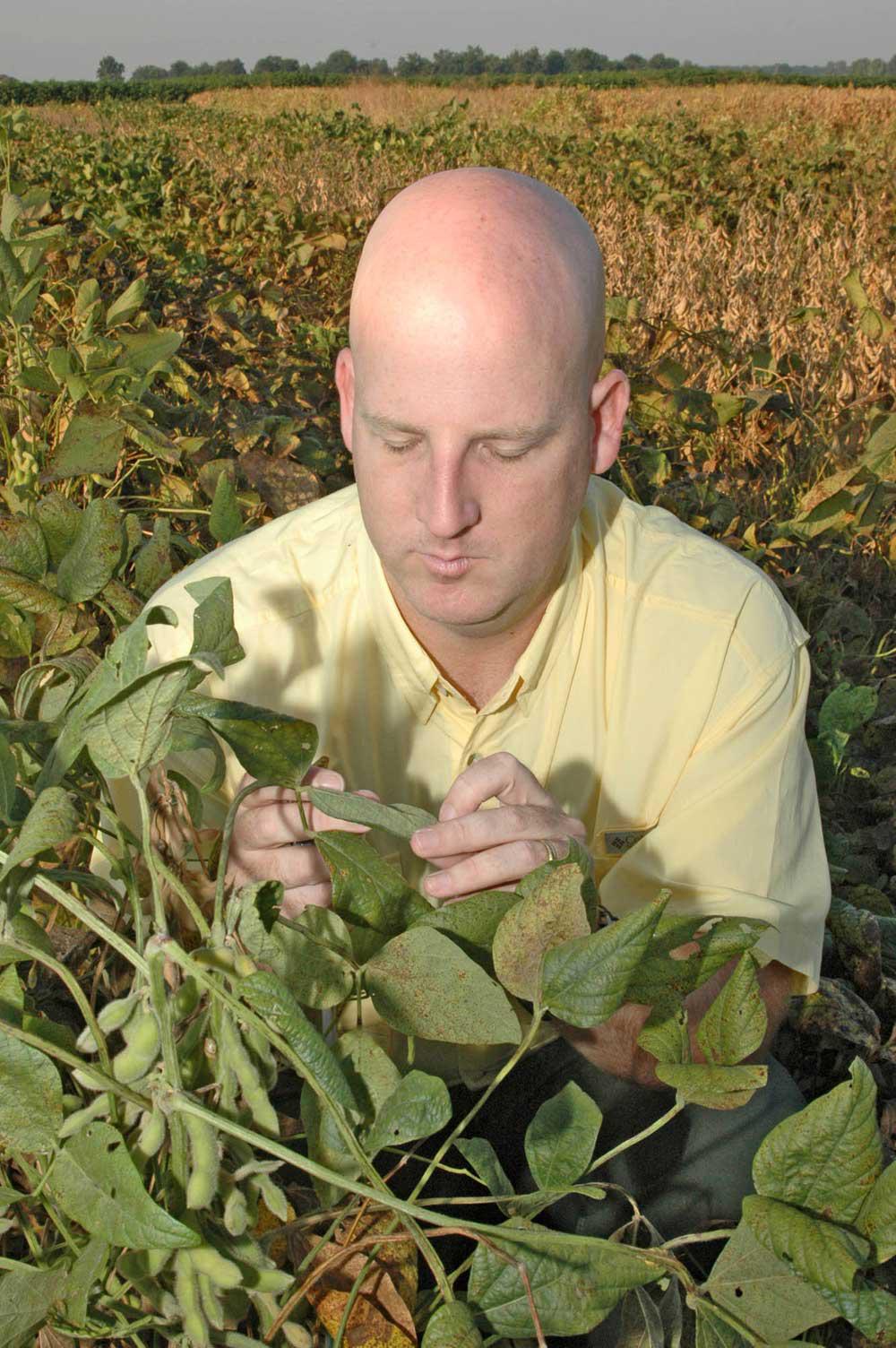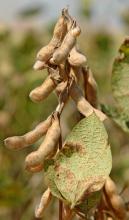Information Possibly Outdated
The information presented on this page was originally released on August 16, 2007. It may not be outdated, but please search our site for more current information. If you plan to quote or reference this information in a publication, please check with the Extension specialist or author before proceeding.
Time to protect the Delta soybean crop
STONEVILE -- Although Mississippi State University Extension personnel found Asian soybean rust in the state’s largest soybean-producing area, the Delta, they anticipate less than 20 percent of the crop is at risk from the potentially devastating disease.
“We’re not too concerned at this point about having found soybean rust in the Mississippi Delta,” said Billy Moore, Extension plant pathologist emeritus.
Rust was found on Aug. 12 during a routine check of a sentinel plot in Washington County. On Aug. 15, it was found in a commercial soybean field in Sunflower County in north Mississippi.
“In about 10 days, about 80 percent of our Delta soybean production will be at the R6 growth stage and more than 50 percent is at R6 (full seed) now,” Moore said. “At R6, don’t worry about soybean rust. Right now, anything less than R5.7 (between seed-fill and touching in the pod) is susceptible to soybean rust. It could get a yield reduction.”
Moore said the high daytime temperatures and drought conditions in the Delta should keep soybean rust from progressing during the next week.
“Soybean rust development does not favor high temperatures and lack of moisture,” Moore said.
“What we are concerned about, only if weather conditions change, is our soybeans planted later in the season after the wheat crop,” Moore said. “They are younger, at the R3/R4 stage (setting pods/full pod), and they’ve got a long way to go.”
Moore said if the weather turns cool with more moisture, soybean rust could become a problem.
“If you want to protect the crop at that time or now, consider a triazole fungicide,” Moore said. “There are a number of them on the market. Be sure to follow the label for using a triazole and keep in mind any time restrictions before harvest.”
Tom Allen, MSU Extension plant pathologist for the Delta, found the soybean rust in a Stoneville sentinel plot. The Extension Service uses sentinel soybean plots each year to monitor the appearance of soybean rust throughout the state.
“I noticed the characteristic raised lesions on the undersides of the leaves,” Allen said. “After performing a stick test, I received a positive response.”
Extension personnel continue to scout sentinel plots and commercial fields in the Delta for soybean rust. They had not found additional occurrences as of Aug. 14.
Moore said he suspects rust in the northwest part of the state has only been found in a sentinel plot in Stoneville because those soybeans are the oldest in the Delta. As soybeans mature, they become more susceptible to rust and other diseases, he said.
Moore said soybean rust may have arrived in the Delta during the July rains.
“Rust probably came in on these unusual weather conditions when this area received from eight to 12 inches of rainfall and had 10 days of cloudy weather about four weeks ago,” Moore said.
Dan Poston, an Extension soybean specialist based at the Delta Research and Extension Center in Stoneville, said soybean rust has moved across the South earlier this year than in previous years.
“We’re usually not picking it up until October or later on some really late-planted beans,” Poston said. “This year, we’re picking it up earlier, but it’s primarily been on sentinel plots with old, diseased, vegetative tissue.”
MSU Extension fungicide recommendations for soybean rust as of Aug. 14, 2007, are as follows:
Soybean producers in southern Mississippi, south of Interstate 20 or in Warren County, should consider a triazole fungicide application if soybeans are at the R1 growth stage. Producers in this area with beans in the R3- to R4-growth stage should consider a strobilurin/triazole fungicide mixture. If producers in this area gave their soybeans an R3 to R4 fungicide application 21 days ago, they should consider a triazole fungicide.
Soybean producers in northwest Mississippi, north of Interstate 20, with spring planted beans that are irrigated, have high yield potential and are in the R5.7 or earlier growth stage should consider using a triazole. R5.7 is when pods are 70 percent filled with beans.
If beans in northwest Mississippi are at the R6 growth stage, Extension personnel feel that a fungicide application for control and prevention of soybean rust would not be warranted. Soybeans are in the R6 stage if beans are touching one another inside pods found on the fourth node down from the top of the soybean plant.
Soybeans in northwest Mississippi planted behind wheat have low soybean rust infection chances as the beans were not in the reproductive stage when conditions were favorable for soybean rust to infect the crop.
Beans planted behind wheat in northwest Mississippi in the R1 to R3 stage do not need a fungicide application. If producers in this area are in a soybean-wheat-soybean rotation, and the soybeans are irrigated, are in the R3-R4 growth stage and have good yield potential, then producers should consider spraying a strobilurin alone or a strobilurin and triazole mix.
Soybeans planted after wheat that do not have a soybean rotation in the past and are dryland may not warrant a fungicide application.
Extension personnel first found rust in Mississippi in 2007 on kudzu in Wilkinson County in the southwest part of the state on July 12. On Aug. 10, rust was detected in soybeans in a sentinel plot in Pearl River County. It was found in the Delta Aug. 12 and again Aug. 15, the same day it also was found in a sentinel plot in Hancock County in south Mississippi.
For more information, contact the nearest county Extension office. For the latest Mississippi soybean rust updates, call the hotline at (866) 641-1847.
Writer: By Robert H. Wells, Delta Research and Extension Center






